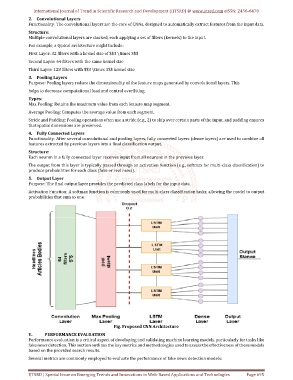Page 705 - Emerging Trends and Innovations in Web-Based Applications and Technologies
P. 705
International Journal of Trend in Scientific Research and Development (IJTSRD) @ www.ijtsrd.com eISSN: 2456-6470
2. Convolutional Layers
Functionality: The convolutional layers are the core of CNNs, designed to automatically extract features from the input data.
Structure:
Multiple convolutional layers are stacked, each applying a set of filters (kernels) to the input.
For example, a typical architecture might include:
First Layer: 32 filters with a kernel size of $$3 \times 3$$
Second Layer: 64 filters with the same kernel size
Third Layer: 128 filters with $$3 \times 3$$ kernel size
3. Pooling Layers
Purpose: Pooling layers reduce the dimensionality of the feature maps generated by convolutional layers. This
helps to decrease computational load and control overfitting.
Types:
Max Pooling: Retains the maximum value from each feature map segment.
Average Pooling: Computes the average value from each segment.
Stride and Padding: Pooling operations often use a stride (e.g., 2) to skip over certain parts of the input, and padding ensures
that spatial dimensions are preserved.
4. Fully Connected Layers
Functionality: After several convolutional and pooling layers, fully connected layers (dense layers) are used to combine all
features extracted by previous layers into a final classification output.
Structure:
Each neuron in a fully connected layer receives input from all neurons in the previous layer.
The output from this layer is typically passed through an activation function (e.g., softmax for multi-class classification) to
produce probabilities for each class (fake or real news).
5. Output Layer
Purpose: The final output layer provides the predicted class labels for the input data.
Activation Function: A softmax function is commonly used for multi-class classification tasks, allowing the model to output
probabilities that sum to one.
Fig. Proposed CNN Architecture
V. PERFORMANCE EVALUATION
Performance evaluation is a critical aspect of developing and validating machine learning models, particularly for tasks like
fake news detection. This section outlines the key metrics and methodologies used to assess the effectiveness of these models
based on the provided search results.
Several metrics are commonly employed to evaluate the performance of fake news detection models:
IJTSRD | Special Issue on Emerging Trends and Innovations in Web-Based Applications and Technologies Page 695

